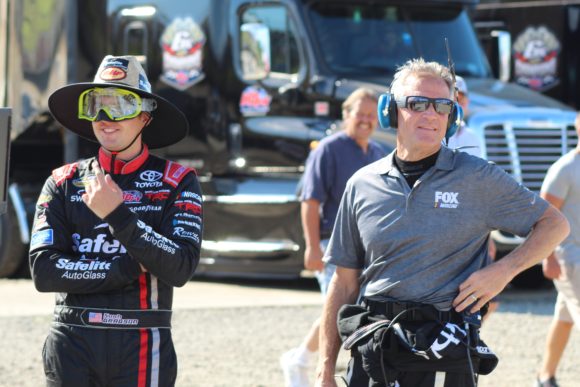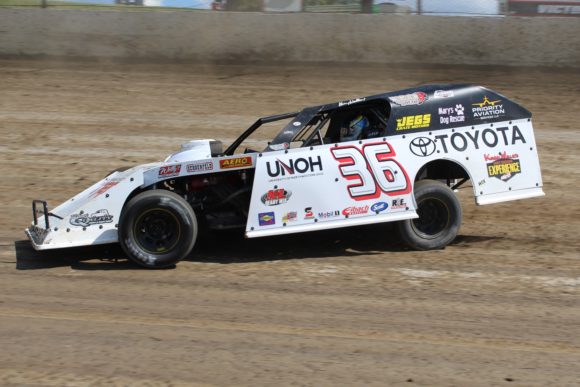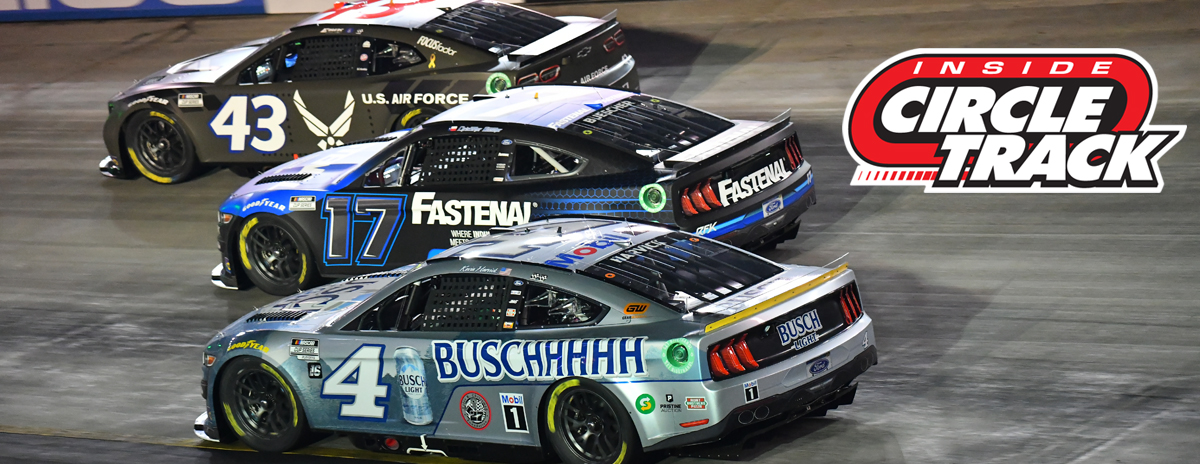
*Turn 2 Blog is a regular feature on InsideCircleTrack.com. Here, site operators Michael Moats and Richard Allen take turns offering their thoughts on the NASCAR and pavement short track racing topics of the day.
In this edition of the Turn 2 Blog we will be discussing five topics regarding short-track racing, whether it be on pavement or dirt.
We are happy to be joined by former NASCAR driver and Fox Sports analyst Kenny Wallace(@Kenny_Wallace on Twitter). Kenny, who races a Dirt Modified car on a regular basis, weighs in on our five questions.
1. If a NASCAR fan who has never attended a dirt race were to ask why he/she should go, what would you tell that person?
Kenny Wallace: DIRT racing is eXciting because the cars are out of control, but in control. DIRT cars are always battling side-by-side and the racing is fast and quick. It is not boring and does not last long so pay attention. It’s over before you know it.
Richard Allen: I would tell the NASCAR fan who has never attended a dirt race to prepare themselves to adopt a totally different mindset when they attend their first race outside of NASCAR. For example, fans at short tracks can buy pit passes and watch the crews prepare the cars, often without a rope or other barrier between them and the crews. And along with that, the drivers are very approachable and most are more than willing to chat or pose for a photo. And once the action starts on the track, be aware that there is no holding back and allowing strategy to play out as virtually all races are less than 100 laps, frequently 50 or less, so no one waits around to make a move. Oh, and bring some safety glasses if you’re going to a dirt track.
Michael Moats: I would tell them to expect cars going sideways at tremendous speeds, slide jobs, and seeing drivers drive as hard as they can for most of the race. I would also add they can get up close and personal with many of the drivers and team members, something virtually impossible in today’s NASCAR.

Kenny Wallace seen here about to interview NASCAR’s Noah Gragson at Eldora
2. What can NASCAR learn from dirt racing that would provide benefits for fans?
Michael: NASCAR needs some rivalries. When it seems like a good rivalry is about to start, someone with NASCAR sits the drivers down and tells them to toe the line. When I was watching it as a kid and into the 80’s and most of the 90’s, rivalries were what it was about aside from the speed and competition. It just seems like everybody is buddies with everyone else except for very few exceptions.
Kenny: NASCAR racing takes too long. In today’s society, people want everything right now and they do not like to wait. DIRT racing fits into the new generation because DIRT racing is fast paced. DIRT racing delivers fast action very quick.
3. What can dirt racing learn from NASCAR that would provide benefits for fans?
Kenny: NASCAR is organized and on time. DIRT racing is not organized and not on time for anything, ever. There might be some tracks that are on time, but for the most part, DIRT racing is horribly late and many of the races do not start until 12 or 1 am in the morning. The hard core fans accept DIRT racing never being on time. But we need to attract the next generation and always being late is bad for DIRT racing. If fans want more time to drink beer, we can do that after the races.
Richard: I couldn’t agree with Kenny any more regarding the need for short tracks to maintain some sort of time discipline. But I would also add that short track owners should go to a NASCAR track from time to time for the purpose of observing their amenities. Restrooms and concession areas are kept clean and there are other things available to do such as race car displays and various attractions to keep kids occupied during down times such as the pre-race. I am not saying that local short tracks have to spend millions of dollars like Daytona International Speedway and Richmond Raceway have but just keeping things clean and have a few entertainment alternatives for the down times could be done with relatively little expense.
Michael: In addition to what both of you have said, dirt racing and short track racing in general, could learn how to better market their drivers and their sport. The national dirt series do a pretty good job of marketing their drivers but could stand to take it up another notch. Regional series and tracks do little to none of it. Drivers have big egos. If they see a couple of drivers at their local track getting promoted by that track, they will want to be part of that and that could help raise car counts.
4. Cost is always a major factor in racing. What’s the one thing as a competitor that you think short tracks(both pavement and dirt) could do to help the competitors in terms of regulating costs?
Kenny: We all agree that everything in racing costs too much because everyone wants the next trick part and I understand that. We cannot stop innovation, but the cost is stopping the sport from growing. On the other hand, when you tell the local racer we are gonna change the rules they bitch and moan because they say “What am I gonna do with the parts I have?” So fixing the rising cost of racing does not have an easy solution. I believe that IMCA is the best game in town and the smartest. Anytime they change a rule they phase it in. For example, when they wanted to save cost for motors they gave a 2” spoiler to anyone that used a 604 crate motor. Many did not think that a 2” spoiler would do anything, but the spoiler was BIG. And before you know it, the local racer was spending $7,000-10,000 on a crate motor instead of $20,000 on a built motor. And it stopped the racers from being jealous of someone having more horse power because everyone had the same motor. The crate motor has saved DIRT racing.
Michael: Of the drivers I have talked to about this subject over the last couple of years, they all say they want a rule book and to stick with it. They get the impression anytime an in-season rule is added, their first thought is they will have to spend more money. And spending more money drives them out of the sport. I had a tech man recently tell me the more rules a track adds to its rule book, the more money is costs the racers.
Richard: I would have to say that having a rule book that is well defined at the start of the season and telling teams that it will remain as it is throughout the year would be a great start. If drivers and crews know that, they won’t go out and get that latest and greatest part then start threatening the track owner by saying they will go elsewhere if that part isn’t made legal. But on another note, I understand that tracks have to make money to stay in business but there are times when they are involved in obvious gouging. Running two-day shows that require teams to buy two sets of arm bands when all they are going to do is hot lap and qualify on the first day is not good for the sport.

Kenny Wallace wheeling his Dirt Modified around Eldora Speedway
5. Short track racing, whether it be dirt or pavement, seems to be more popular than ever among current NASCAR drivers. This is an overall positive for short track racing, right?
Richard: The fact that Kyle Busch or Kyle Larson or Kasey Kahne or Christopher Bell might show up at a local short track will put more eyes on that track or series and will put more butts in the grandstand seats. And it will bring out reporters who have far more followers on social media than those who routinely cover short track racing, and thus, will stir more interest. There’s no way that’s a bad thing.
Michael: I applaud the drivers that still get back to their roots even as they are racing Cup or Xfinity. Seeing Kyle Busch competing at a local short track in January with a smile on his face should be a gold mine for the sport. If there is one downside, most of these come from a particular type of racing when there are so many forms of short track racing to showcase. Hopefully, the notoriety of Busch, Larson, etc. will trickle down to all forms of short track racing.
Kenny: A big percentage of NASCAR drivers started on DIRT. We all remember our roots and we truly love racing and want to pay it forward. I know for a fact that race car drivers like myself have helped the growth of DIRT racing. For 15 years I used my platform to get on National TV (FOX Sports) in front of millions of viewers and tell them how great DIRT racing is. And now you have others doing the same. NASCAR drivers have proven to help DIRT racing.
Respond to this post on Twitter by following @RichardAllenIDR and @MichaelRMoats or by liking the InsideCircleTrack.com Facebook page.
Also, dirt racing fans can check out InsideDirtRacing.com for more racing content.
